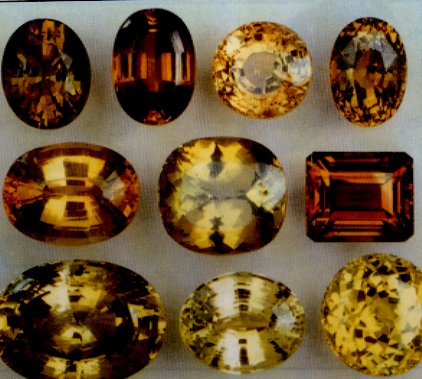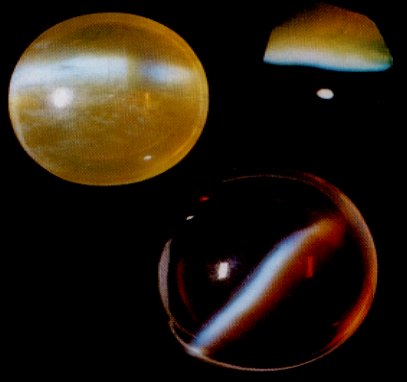
ÇáÇÍÌÇÑÇáßÑíãÉGemstone coarse(ERSCI 1005)


This photo shows you your astrologic stone

Chrysoberyl

Cate eye chrysoberyl

Opal
Gemstones
Defintion of gemstone A gem is a stone of natural origin. The term also includes organic gem materials, such as pearl, amber and corals, and excludes all manufactured simulants, which are called syntthetic gems. The major task of the gemologist is to determine whehter a stone is natural or synthetic and to know w hether its color is natural or has been artificially induced. Interest in gems extends beyond the dawn of history. The peoples of ancient civilizations valued gems as objects of beauty and as a source of supernatural powers; they protected against diseases, poison and fire and gave strength and wisdom.
Qualification of gems Of the more than known mineral species, about meet the qualifications to be placed in the category of gem minerals, and of these about can be considered as important gem minerals.
Beauty is the most importnat attribute of gemstones. Beauty lies in color, luster, transparencey, cutting, brilliance and fire. Most gems possess two or more of these qualities. Turquois’s beauty lies in its color alone, whereas the attractiveness of opal lies in its fire spectral color difractions, a phenomenon known as iridescence (play of color).
Durability or hardness of the mineral is the second requisite. The gemstone has to be hard enough to resist abraision. A minimum hardness of quartz (H= ) is required.
Rarity is another factor that influences the desirability of a gem, which is also the vagaries of fashion.
Portability is another factor, and gemstones are unique in combining high value with small volume.
Types of gem cuts:
There are two basic types of cuts:
I - Cabachon cut, which has a snoth-domed top and flat base
II - Faceted cut, in which the gem is bounded by polished surfaces, or facets
Important gems: n
Diamond: All through the history, diamond has held the preeminent position as the most coveted gem. It is vlaue results from its hardness, brilliant luster and spectral colors. The Greeks called it adamas, the invincible, from which the word diamond is derived. Diamonds graded into many categories on the basis of color, clarity, cut and carat weight (one carat = gramme). The larges diamond, called cullinan ( carates) was found in South Africa. About of diamonds products are of industrial grade. Notable localities: India, Brazil South Africa, USSR, Australia. n
Beryl
Beryl occurs in several colors: colorless beryl is called goshenite, pink beryl is called morganite, blue-green beryl is called aquamarine and yellow beryl is called golden beryl. Emerald has a deep green color and has a vlaue equal to or greater than diamond. Localities: Colombia, Australia, South Africa, Zimbabwe.
-Corundum
Corundum occurs in two color varities: red corundum is called ruby, and the blue varity is called sapphire. Localities: Burma, Kenya, Thialands, Sri Lanka. n
Opal
The great value of opal lies in the beauty of its display of colors. Localities: Australia, Mexico, Hungary.
-Jade
Jade is characterized by extreme toughness and green color. It indicates pyroxene as well as tremolite-actinolite. Localities: Burma, China, New Zealand
-Chrysoberyl
It is a transparent gemstone with high degree of hardness ( ) and pleasing colors of yellow, green or brown. Cat’s eye and alexandrite are tow varieties. Alexandrite changes color from red in artifical light to green in daylight. Localities: Sri Lanka, USSR
-Tourmaline
This stone occurs in shades of all colors. Localities: Sri Lanka, Brazil
-Turrquoise
This gemstone is valued for its color. Most valuable stones are from Iran, China and New Mexico.
-Garnet
Garnet occurs in different colors; pyrope and almandine occur in red and violet. Grossular is orange to brown. Uvarovite is the green variety. Localites: in many countries.
-Zircon
Zircon is sold under the name starlite. The popular color varity is blue. Localities: Sri Lanka, China
-Olivine (peridot):
This is an olive-green gem. Localities: Zebirget Island (Red Sea), Burma, Australia.
Methods and instruments used to determine gem properties
The gemologist is restricted to non-destructive tests. The first step in identification of a gem is to observe its physical properties, like color, luster, and spectral colors. The most important tool is a simple X hand lens. For critical examination it is necessary to use a microscope. Important properties of gems like refractive index, are measured with a refractometer. For studying color spectra we need a spectrometer or a spectroscope. The most definitive information is provided by an X-ray powder diffractometer.
Synthesis of gem materials
Four methods of gem synthesis are known at present:
-Verneuil Process: In this method, a powder with the required chemical composition (e.g., Aluminum oxide for rubyy, plus coloring agent) is melted in a flame. A droplet of the fused powder falls on a ceramic plate and cools. The crystals of synthesized ruby are characterized by pubbles and striations, or growth lines. -
Czochralski Process: A seed crystal held on the end of a rotating rod is touched to the surface of the melt and then slowly withdrawn.
-Flux Growth: A powder of the desired composition is mixed with a flux of low melting point.
Hydrothermal Growth: This involves preparing an autoclaves, or closed tubes, for crystal growth using high temperature.
Treatment of Gemstones
The color of gemstones can be changed by treatments with the following methods:
-Dyeing
This is a method of stainng the gemstone with an appropriate dye. It is most effective in coloring chalcedony, jade and turquoise.
Heat treatment
Heating the gemstones can results in color change. This can be used on zircon, quartz, beryl and topaz.
Impregnation
A play of color can be induced in some opals by immersing them in water or impregnation with plastic.
Astology and gemstones
A strology has always played a part in the superstitions surrounding gems. A particular stone was believed to possess special virtues if worn under zodiacal control, that is, during a given month. A particular gem was assigned to each sign of the zodiac, and the use of mont stones or birthstones gradually evolved.